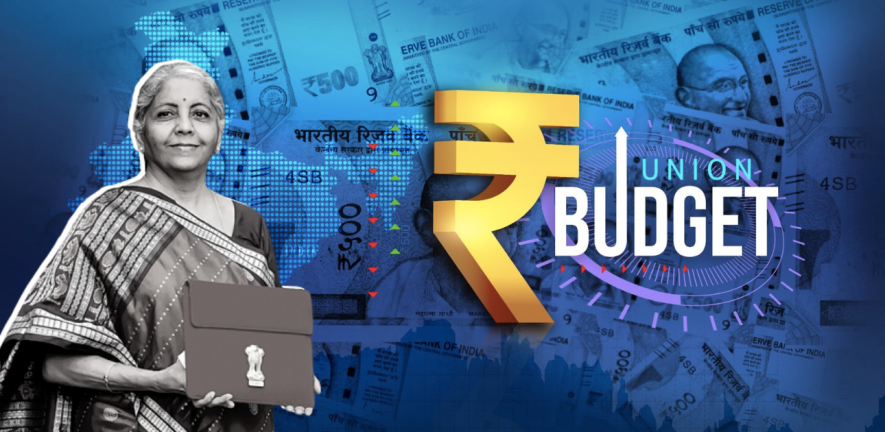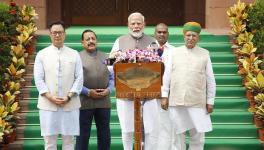Union Budget 2023–24: Long-Term Strategy is Unstable

Representational Image.
The government’s growth strategy based on promoting inequity and cronyism is proving to be highly unstable. The Union Budget 2023–24 needs to be modified to promote development from below, as Mahatma Gandhi suggested, which would lead to equitable, long-term growth.
—–
A budget is based on an analysis of the current economic situation, the scenario likely to prevail in the coming year, and on giving direction to the economy in the longer run.
There are different kinds of lags between the announcement of policies and their implementation. For instance, allocation to the Mahatma Gandhi National Rural Employment Guarantee Scheme has an immediate impact on employment generation, but a policy for skilling the youth will take years to have an impact. A policy to step up research and development (R&D) to make India atmanirbhar may take over a decade. These two policies would also require changes in education policies.
The Union Budget 2023–24 needs to be analysed both for its short-term and long-term impact on the country and its economy. Unfortunately, often the short-term dominates over the long-term, with the ruling party prioritising the immediate, especially near elections when the party needs to attract voters by offering concessions. However, for the country, the long-term is critical so that the economy can be put on a sound footing.
Contradictions between short-term and long-term policies lead to their failure. Thus, there is a need to coordinate between the two.
Taking away more than giving
The ruling party often camouflages its strategy to appear to be compassionate towards the poor. So, while in words it may appear to favour the marginalised sections, in reality it may be working for the interest of its backers, the big businesses.
The Union Government has been doing so over the last many years by pursuing ‘supply side’ policies that favour businesses. This is behind the façade of pro-poor policies. So, the marginalised sections have been given free food and cooking gas, and farmers have been given some cash, among other things. Politically, it has been successful in claiming to be concerned for the marginalised. Yet, the reality is that the marginalised have been losing far more than they have gained in the last many years, leading to rising disparities and distress.
The marginalised sections belong to the unorganised sector, which employs 94 per cent of the labour force. They have been hit hard since the time of demonetisation in November 2016. The structurally-faulty Goods and Services Tax, the non-banking financial companies’ crisis, forced digitisation and attempts to formalise, and finally, the sudden lockdown have further decimated this sector. All these policies have been designed to strengthen organised sector businesses. As a result, the unorganised sector has lost lakhs of crores of incomes every year since 2016. This is a multiple of what the government has given them under various schemes.
The Union Budget 2023–24 continues with this strategy. Part A of the Union Finance Minister’s speech announces schemes for the marginalised — for farmers, women, dalits, tribals, workers, senior citizens, medium-, small- and micro-enterprises, and so on. What they get is little and due to the persistent losses since 2016, these sections have become permanently dependent on government support and feel politically obliged to the ruling dispensation.
The Atmanirbhar Bharat Scheme announced in May 2020 is a case in point. It offered Rs. 22 lakh crore, of which the support to the marginalised was not even Rs. 3 lakh crore; the rest was all targeted at businesses. It is the marginalised who suffered the most and they got a measly amount to survive.
The government, following ‘supply side’ policies, believes that concessions to businesses would lead to higher investment and boost the economy. This did not happen, given the shortage of demand due to the marginalised losing purchasing power. Private investment did not rise to boost the economy.
The government has raised its investment to boost the economy, but the private sector has not obliged since demand remains short. The consumer confidence index of the organised sector is at 85 while it was 104 prior to the pandemic. That is why capacity utilisation in the organised sector is at 72 per cent, which is too low to push higher private investment.
The government is content to claim that India is the fastest growing large economy. But the growth data is incorrect because it is based on the organised sector only. The unorganised sector, which is declining, is largely proxied by the organised sector. This gives an upward bias to the growth of the Gross Domestic Product (GDP). The International Monetary Fund and the United Nations use this erroneous government data since they are not data gathering agencies.
In brief, the economy is in decline and is not growing. The unorganised sections are marginalised, both in data and policies. If the government feels that the economy is doing well, then the ‘supply side’ is working and nothing special needs to be done for the marginalised.
Long-term strategy
The Finance Minister’s speech states at the beginning that this is the first budget of Amrit Kaal, that is, it presents the strategy for the economy for the next 25 years. Seven priorities covering everything are listed, which like the Saptarishi are supposed to guide the economy.
The priorities of the government are reflected in allocations; more so, whether they are maintained or cut if the deficit in the budget increases. For instance, in 2022–23, to keep the fiscal deficit at the budgeted level of 6.4 per cent of the GDP, expenditures on many essential heads have been curtailed. Revised estimates for 2022–23 show cuts in education, health, social welfare, Pradhan Mantri Kisan Samman Nidhi, agriculture and allied activities, transfers to states, and urban development. These cuts are in spite of revenues rising by 6.8 per cent over the budgeted amount.
Certain expenditures have been increased. Revised estimates for 2022–23 show increases in two kinds of items. One, in the essentials that had been cut in the 2022–23 budget compared to 2021–22 and had to be increased. Two, where allocation is substantially increased in 2022–23 over the previous year’s allocation. Examples of the first kind are, food and fertiliser subsidies, rural development and scientific developments. For the second kind there is energy, information technology and telecom, and transport. The latter category is what businesses are interested in since it gets contracts to implement them.
What does all this indicate? First, announcements do not mean that implementation would necessarily follow. This is especially true for items that go to the marginalised sections. Second, the heads that are of interest to businesses increase even if the budget deficit rises. Third, expenditure heads that cater to the public at large get reduced in case the deficit increases. This clarifies the priorities.
The long-term strategy of the Union Government, which is not spelt out anywhere, is to promote not only businesses, but select big business. This has been at play since 2014. Some businessmen have been enabled to acquire other businesses through government actions. Further, they have been allotted new infrastructure projects. So, some of these top Indian businessmen have quickly garnered more wealth than most of the global rich. Their rise is based on cronyism and not innovation, as is the case for many of the global rich.
Rocky road
The Government is trying to copy the South Korean strategy of enabling big conglomerates to emerge, which can become global behemoths. These Korean entities invested heavily in R&D, and South Korea promoted education and especially higher education.
Critically, South Korea developed in a different environment than the present one. It was a bulwark against the spread of communism. The West allowed it access to technology and markets. Today, the United States is wary of allowing easy access to technology, and there is de-globalisation, which is slowly reducing market access. For success, India has to develop its own technology, but that is not in evidence. A big push to education and R&D is required, but the budgets for these items have been curtailed, indicating a low priority to them.
Crony capitalism leads to a deterioration of the investment climate. Businesses worry that they could be taken over. No wonder, a large number of rich Indians have been leaving India. This setback is in addition to the decline in investment due to inadequate consumption and shortage of demand. It has also meant that public sector investment has not pulled in private investment.
Adani imbroglio illustrates the failure
On the budget day, the pitfalls of the strategy of cronyism became apparent as the Adani Group continued to collapse. Reports of its sharp practices had come out. The group must have believed that it could get away with anything, given the backing of the government. But what was not factored in was that international investors could see an opportunity to short the shares of the group’s companies and make a killing. The government has no control over international finance.
The withdrawal of the Follow on Public Offer (FPO) illustrates that the group and the government had lost control over the goings-on. The FPO was tanking since the market prices had dropped way below the offer price. Why would anyone subscribe to the FPO when they could obtain the shares much cheaper in the market? Subscription could only be under some pressure or by round-tripping the group company’s own money. International capital saw through this stratagem. Banks stopped accepting shares of the company as a collateral since it is not clear how low the price would fall. This reduced confidence of investors in the shares of the company even more and they fell further.
In brief, the government’s growth strategy, based on promoting inequity and cronyism, is proving to be highly unstable. The Union Budget 2023–24, based on this strategy, is not what the country needs. It needs to be modified sooner than later to promote development from below, as Mahatma Gandhi suggested, which would lead to equitable, long-term growth.
Arun Kumar is a Retired Professor of Economics at the Jawaharlal Nehru University.
Get the latest reports & analysis with people's perspective on Protests, movements & deep analytical videos, discussions of the current affairs in your Telegram app. Subscribe to NewsClick's Telegram channel & get Real-Time updates on stories, as they get published on our website.
























